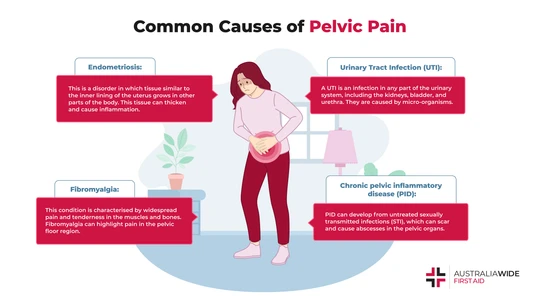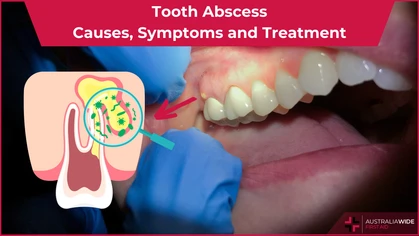Pelvic Pain in Women: 6 Common Causes and How to Treat Them

General Health-Related

Pelvic pain is pain felt in the pelvis, the area of the body that is beneath the belly button and above the legs. Pelvic pain can be symptomatic of more serious health complications. And if left untreated, it can lead to serious physical and emotional problems.
Pelvic pain is pain felt in the pelvis, the area of the body that is beneath the belly button and above the legs. The pelvis contains several vital organs, including the bowel, bladder, uterus (womb), ovaries, and fallopian tubes. As such, there are several possible causes for pelvic pain, including problems with the musculoskeletal, reproductive, or urinary systems. According to Australia’s Pelvic Pain Foundation, pelvic pain is estimated to cost Australia more than $6 billion annually, in part because of its impact on women, their quality of life, and their productivity at work. It is important to know the distinctions between common causes of pelvic pain, so you can seek the proper treatment. Continue reading for an in-depth look at the nature, causes, and complications of pelvic pain. We will also explore some easy ways to promote good pelvic health.What is pelvic pain?
Pelvic pain is pain felt in the pelvis. The pelvis is the area of the body that is located below the abdomen, beneath the belly button and above the legs. It comprises a basin-shaped complex of bones, including the hip bones, sacrum, and coccyx, that connect the trunk of the body to the legs. As well as providing balance and support to the trunk, the pelvis contains and supports the bladder, intestines, and reproductive organs. There are two main types of pelvic pain: acute and chronic. Acute pelvic pain is generally regarded as pain in the pelvis that is sudden, severe, and lasts less than three months. Chronic pelvic pain, meanwhile, generally refers to pain in the pelvis that lasts longer than 6 months. Chronic pelvic pain may be constant, or it may come and go. Regardless of whether it is acute or chronic, pelvic pain can present in many different forms, as described by the United Kingdom National Health Service:- A sharp, stabbing or burning pain that happens suddenly.
- A pain that comes on slowly but does not go away.
- A dull or heavy ache, or a feeling of pressure.
- A twisted or knotted feeling.
- A cramping or throbbing pain, which may be recurrent.
- Pain only when you’re performing a specific activity, such as exercise, sex, or urination.
Common causes of acute pelvic pain
According to John Hopkins Medicine, common causes of acute pelvic pain can include:Ectopic pregnancy
An Ectopic pregnancy occurs when a fertilised egg implants and begins to grow outside of the uterus, typically in a fallopian tube. They are most often caused by an inflamed or misshapen fallopian tube, though they can also be triggered by hormonal imbalances or birth defects. Ectopic pregnancies cannot continue as normal. As the fertilised egg continues to grow, it can rupture the fallopian tube and cause heavy bleeding. As such, if you experience any of the early symptoms of ectopic pregnancy, including light vaginal bleeding and pelvic pain, you should consult a healthcare professional immediately.Pelvic inflammatory disease (PID)
Pelvic inflammatory disease (PID) is an infection of one or more of the female reproductive organs found in the pelvic area. PID occurs when an infection spreads from the vagina to the cervix, followed by the endometrium (lining of the uterus) and fallopian tubes. PID is generally caused by untreated sexually transmitted infections (STIs), such as gonorrhoea or chlamydia. PID can cause scar tissue and abscesses to develop in the reproductive tract, and ultimately make it difficult for a woman to fall pregnant. As such, if you experience any of the early symptoms of PID, including unusual vaginal discharge and pelvic pain, you should consult a healthcare professional immediately.Urinary Tract Infection (UTI)
A urinary tract infection (UTI) refers to an infection in any part of the urinary system, including the kidneys, bladder, or urethra. UTIs typically occur when bacteria enter the urinary tract and begin to multiply. Though there are many germs that can cause UTIs, they are most commonly caused by Escherichia coli (E. coli), a type of bacteria that is found in the intestines of most humans and animals. Compared to men, women are more likely to get UTIs, as their urethra is short, straight, and sits close to the anus, where E. coli is present. Without treatment, UTIs can result in permanent kidney damage and sepsis. As such, if you experience any of the early symptoms of a UTI, such as pelvic pain and a strong, persistent urge to urinate, consult a healthcare professional immediately.Common causes of chronic pelvic pain
Common of causes of chronic pelvic pain, meanwhile, can include:Endometriosis
Endometriosis is a painful condition in which tissue that is similar to the inner lining of the uterus grows on other parts of the body. This tissue thickens, breaks down, and bleeds with each menstrual cycle. However, because it has no way to exit the body, it can irritate surrounding tissue and cause it to develop adhesions, fibrous bands that cause internal body surfaces to stick together.Fibromyalgia
Fibromyalgia is a condition characterised by widespread pain and tenderness in the muscles and bones. It is also sometimes accompanied by fatigue and cognitive difficulties. Many researchers believe that fibromyalgia is caused by repeated nerve stimulation, which can change the way the brain and spinal cord process painful and non-painful signals. As such, fibromyalgia can highlight pain in the pelvic floor region.Irritable bowel syndrome
Irritable Bowel Syndrome (IBS) is an intestinal disorder that affects the colon (large bowel). IBS is generally characterised by abdominal pain, stomach bloating, and irregular bowel habits. The exact cause of IBS is unclear, though it can be triggered by emotional stress, food intolerances, or bacterial infections in the digestive tract, such as gastroenteritis. The chronic constipation and diarrhoea associated with IBS can increase the risk of pelvic organ prolapse. Pelvic organ prolapse occurs when the muscles that support the pelvic organs become weak or loose, which can lead to the organs falling out of place and causing pelvic pain.Complications of pelvic pain
If left untreated, pelvic pain can lead to the following complications:Depression
Depression is an umbrella term for mental health conditions that negatively impact how a person thinks, feels, and acts. One of the most common types of depression, Major depressive disorder (otherwise known as Clinical depression) is typically characterised by persistent feelings of sadness, and a loss of interest in activities that were once enjoyed. The link between depression and chronic pain is reciprocal. For instance, depression can make the body more sensitive to pain, and thereby exacerbate the symptoms of pelvic pain. The frustration of trying to diminish the symptoms of pelvic pain, meanwhile, can exacerbate feelings of hopelessness. Without help, people with depression can experience a variety of physical and emotional complications, including substance abuse and social isolation, and cease to function normally in their personal and professional relationships.Insomnia
Insomnia is a sleep disorder in which a person experiences persistent difficulties with falling and staying asleep. People with insomnia can begin to experience sleep deprivation, where the body does not get enough sleep to function correctly. Sleep deprivation is commonly signalled by excessive sleepiness, frequent yawning, and daytime fatigue. Alongside mental health conditions, neurological problems, and other sleep disorders, chronic pain is largely identified as one of the most common causes of insomnia. Chronic pain, such as that experienced in the pelvis, stimulates nerves and activates the brain, which forces it to remain awake. Without treatment, insomnia and the resultant sleep deprivation can cause a person to perform poorly at school or work, as well as increase their risk of mental health conditions and poor markers of health, including high blood pressure.How to treat pelvic pain
If you think your pelvic pain may be symptomatic of a more serious health condition, such as those mentioned earlier, you should consult a healthcare professional as soon as possible. Pain in the pelvis can also be linked to a weak pelvic floor. The pelvic floor muscles are those that support the bladder, uterus, and bowel. They are located between the coccyx and the pubic bone. The pelvic floor muscles can be weakened by several contributing factors, including:- Pregnancy, as the uterus can weigh the muscles down and make them weak.
- Vaginal childbirth, as this can strain and overstretch the muscles.
- Menopause, as low levels of oestrogen can cause the muscles to become thinner and less flexible.
- Painful periods, as these can cause tension in the muscles.
- Chronic constipation, as straining to poo can tighten and stress the muscles and the organs they support.
How to strengthen the pelvic floor
The following lifestyle changes can help strengthen the pelvic floor:- Squeeze and hold your pelvic floor muscles when you sneeze, cough, or lift something heavy.
- Only urinate when you need to, otherwise you may inadvertently train your bladder to empty more often.
- Empty your bladder completely when you go to the toilet.
- Ingest plenty of fibre-rich foods and water to soften your stools and avoid constipation.
- Don't lift heavy loads too often, and avoid bouncing exercises.
- When sitting on the toilet, learn forward and elevate your knees slightly higher than your hips by resting your feet on a small stool or step. Likewise, rest your elbows on your knees or thighs to straighten your back, and gently bulge your abdomen. This position will help relax your pelvic floor and sphincter muscles and avoid straining.
- Squeeze and draw in the muscles around your anus and vagina at the same time as if you are trying to stop a wee.
- Hold the squeeze for 8 seconds (or as long as you can) and then relax for 8 seconds.
- Repeat the squeeze 8 to 10 times (or as many times as you can) with an 8 second break between each squeeze. This equals 1 set.
- Try to do 3 sets per day.
- While doing the squeezes, keep breathing normally, relax the thighs, and avoid tightening the buttocks.
Looking to get you First Aid knowledge up to date?
We run certified First Aid courses throughout all major Acustralian citys. Find a location near you.
Final thoughts
Pelvic pain is pain felt in the pelvis, the area of the body that is located beneath the belly button and above the legs. The pelvis contains a basin-shaped complex of bones that connects the trunk of the body to the legs. It also contains the pelvic floor muscles, which support the bladder, uterus, and bowel. Pelvic pain can be caused by more serious health conditions, including endometriosis, fibromyalgia, and ectopic pregnancy. However, it can also occur when the pelvic floor is weakened by pregnancy, menopause, or constipation. As such, in some instances you can reduce the effects of pelvic pain with a few lifestyle changes, like eating more fibre-rich foods, training your bladder to empty less often, and drawing in the pelvic floor when you sneeze, cough, or lift something heavy. In other instances, you may need to visit a healthcare professional to figure out the root cause of your pelvic pain. Pelvic pain is an enormous burden on Australian women, and it can impact their ability to function normally at work and home. Pelvic pain is not a normal part of life, and if you are suffering from pelvic pain, you do not need to suffer in silence. Visit a healthcare professional and keep asking questions until your concerns have been heard.
Originally published at
https://www.australiawidefirstaid.com.au/resources/pelvic-pain-in-women
as part of the Australia Wide First Aid Articles Library









